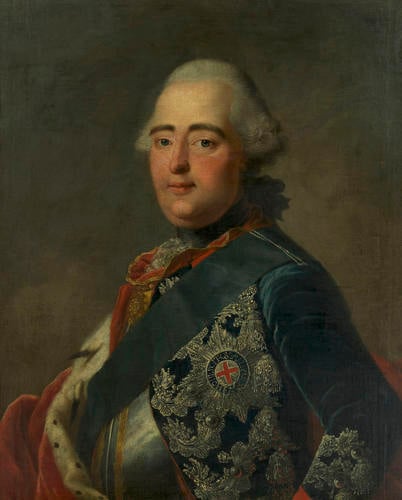Friedrich II, Landgrave of Hesse-Cassel (1720-1785) 1760
Oil on canvas | 82.5 x 66.0 cm (support, canvas/panel/stretcher external) | RCIN 402499
-
Nicknamed the "Kassler" Tischbein, Johann Heinrich Tischbein the Elder was the most successful member of the large Tischbein artistic dynasty. He first trained in Kassel under a wallpaper maker named Zimmerman. Then, in 1744, with the support of Graf Stadion, he became a pupil of Carl van Loo in Paris; and afterwards, in 1749, was apprenticed to Giovanni Battista Piazetta in Venice, where he spent time copying both Titian and Veronese. He returned to Germany in 1751 and became court painter in Kassel to Landgrave William VIII von Hesse; apart from a few short sojourns he remained in Kassel for the rest of his career.
At his best, Tischbein stands amongst the foremost portrait painters of the Eighteenth Century. Like Ziesenis, his style marks a transition between whimsical Rococo and the nascent Hellenic Classicism of theorists like Winckelmann. With the rise of Classicism towards the end of his career, his palette became darker and his mood increasingly more serious. As well as a substantial amount of portraits he also painted a number of mythological, religious and genre scenes. Notably, he provided paintings for Wilhelm VIII's so-called "Schönheitsgalerie" in Wilhelmsthal, his summer palace. He was particularly skilled in his portrayal of women.
Friedrich II of Hesse-Cassel was the son-in-law of George II of England. He is rumoured to have had more than one hundred children. At the onset of the American Revolution, George III hired twelve thousand of the Duke's soldiers to fight for over £3,000,000. With the money, Friedrich II encouraged the economic and intellectual development of his small country, building schools and museums and reducing taxes. He is remembered today as one of Germany's more enlightened despots. In this portrait he we sports the riband and star of the Order of the Garter.Provenance
Bought Queen Mary at Christies 4th November 1949 (Lot 156); said to have been sold by the German Embassy
-
Creator(s)
-
Medium and techniques
Oil on canvas
Measurements
82.5 x 66.0 cm (support, canvas/panel/stretcher external)
93.0 x 78.9 x 5.7 cm (frame, external)
Category
Object type(s)
Alternative title(s)
Frederick II, Landgrave of Hesse-Cassel (1720-1785)








